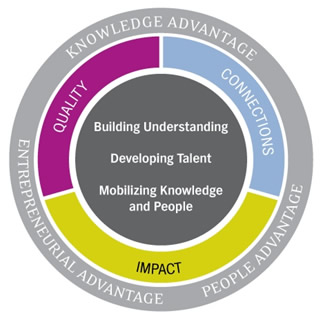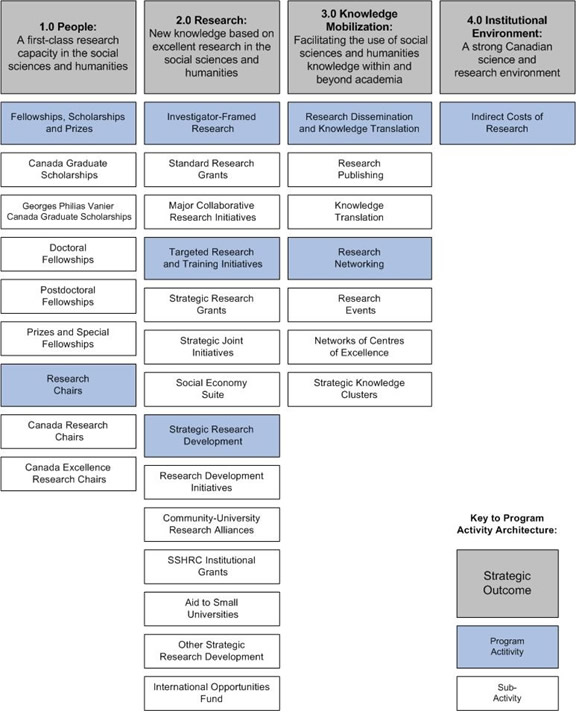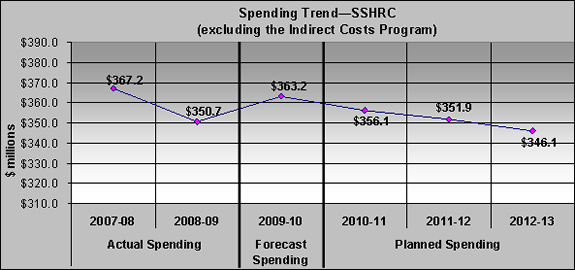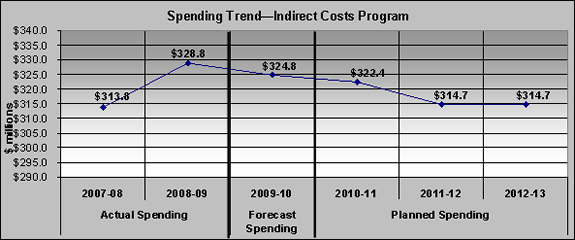Common menu bar links
Breadcrumb Trail
ARCHIVED - Social Sciences and Humanities Research Council
 This page has been archived.
This page has been archived.
Archived Content
Information identified as archived on the Web is for reference, research or recordkeeping purposes. It has not been altered or updated after the date of archiving. Web pages that are archived on the Web are not subject to the Government of Canada Web Standards. As per the Communications Policy of the Government of Canada, you can request alternate formats on the "Contact Us" page.
MINISTER'S MESSAGE
 Our government is committed to positioning Canada
to exit the current downturn quickly and emerge stronger and more competitive in the global economy. In doing so, Industry
Canada and its Portfolio partners will continue to play their key roles in increasing the country's capacity to create jobs
and economic growth–for next year and the next decade.
Our government is committed to positioning Canada
to exit the current downturn quickly and emerge stronger and more competitive in the global economy. In doing so, Industry
Canada and its Portfolio partners will continue to play their key roles in increasing the country's capacity to create jobs
and economic growth–for next year and the next decade.
While the recession originated beyond our borders, it had real consequences for Canadians and Canadian business. And despite
improving conditions, there is work to be done. In 2010, a major focus will be completing the stimulus measures of
Canada's Economic Action Plan.
Introduced in Budget 2009, the Plan's full effect will be felt in 2010–11, and its measures will help solidify the recovery.
Over this period, Industry Canada and its Portfolio partners will work with industries and sectors hit hardest by the recession. Initiatives will include activities to boost community economic development and to extend broadband infrastructure to underserved or unserved areas across the country. To build on the momentum gained through our past investments in science and technology, significant effort will be directed to shaping the knowledge-based economy.
Industry Canada will also focus on supporting business and industry to capitalize on emerging opportunities at home and abroad. Getting our economic frameworks right, through forward-looking policies, is central to ensuring Canada's place in the global marketplace. We remain committed to two-way trade and investment, which raises our capacity to create jobs and economic growth and provides for sustainable prosperity.
In 2010–11, the Social Sciences and Humanities Research Council of Canada (SSHRC) will provide students with fellowships and training opportunities, thereby contributing to the strength and flexibility of the workforce, and will award prestigious research chairs to expand our capacity in priority areas. It will fund research and build on prior investments in management, business, finance, the environment and northern communities. SSHRC will also renew its program architecture to further benefit society.
I will work with my colleagues, the private sector and other governments to advance the recovery and build the foundation for a strong, competitive economy.
It is my pleasure to present this year's Report on Plans and Priorities for the Social Sciences and Humanities Research Council.
Tony Clement
Minister of Industry
I. DEPARTMENTAL OVERVIEW
1.1 Raison d'Être
Social sciences and humanities research advances knowledge and builds understanding about individuals and groups both in Canada and throughout the world. It informs us about who we are, how and where we live, what we create and why we act the way we do. In short, it tells us what it is to be human. Through research funded by the Social Sciences and Humanities Research Council (SSHRC), Canadians are better informed about themselves and the world around them.
In this way, the social sciences and humanities play an important role within Canada's science, technology and innovation system. SSHRC-funded researchers contribute to important developments in environmental, economic and wellness research. The work they do addresses the critical social, cultural and political issues facing Canadians, and leads to innovations in products, services and technology. SSHRC's strategic outcomes, linked to its ambitions of quality, connections and impact, help implement the federal science and technology (S&T) strategy, Mobilizing Science and Technology to Canada's Advantage. SSHRC supports:
- People–creating a first-class research capacity in the social sciences and humanities to build a People Advantage;
- Research excellence–creating new knowledge to heighten Canada's Knowledge Advantage;
- Knowledge mobilization–facilitating the use of research to contribute to Canada's Entrepreneurial Advantage; and
- The institutional environment–providing Canada with a strong setting for science and research, and helping it achieve world-class excellence.

SSHRC also actively contributes to the S&T strategy's priority research areas and activities. SSHRC's support for people, research and knowledge mobilization ensures a strong supply of expertise to a broad spectrum of disciplines, including law, design, marketing, finance and business. These experts draw on their training in the social sciences and humanities and on the results of the latest research to translate knowledge into commercial applications.
SSHRC researchers are further engaged in work related to many of the subpriorities identified by the Science, Technology and Innovation Council in 2008. Areas of application include research about water supply and security, climate change adaptation, new media and communications, the Arctic, and Canada's aging population.
Consistent with the S&T strategy, SSHRC encourages partnerships and increasingly supports researchers working with their counterparts from other disciplines, including engineering and the natural and health sciences, and from other branches of the economy, such as the private, public and not-for-profit sectors. An enhanced ability to support collaborative research is one of the key goals of SSHRC's program architecture renewal, now underway.
1.2 Responsibilities
SSHRC is an agency that reports to Parliament through the Minister of Industry. It was created through an act of Parliament in 1977 and was mandated to:
- promote and assist research and scholarship in the social sciences and humanities; and
- advise the Minister in respect of such matters relating to such research as the Minister may refer to the Council for its consideration.
To fulfill this mandate, SSHRC runs programs that provide Canadian researchers with grants, scholarships and fellowships, observing the terms of the federal Policy on Transfer Payments. SSHRC is also responsible for administering the following tri-agency programs on behalf of the Natural Sciences and Engineering Research Council (NSERC) and the Canadian Institutes of Health Research (CIHR):
- the Canada Research Chairs Program;
- the Canada Excellence Research Chairs Program; and
- the Indirect Costs Program.
Lastly, SSHRC works with Industry Canada and with NSERC and CIHR to support Networks of Centres of Excellence initiatives.
1.3 Strategic Outcomes and Program Activity Architecture for 2010-11

Note: Internal Services is a separate program activity, but is not linked to a strategic outcome. Activities falling under Internal Services include:
- Governance and Management Support;
- Resource Management Services; and
- Asset Management Services.
1.4 Program Activity Architecture Crosswalk
The title of Program Activity 1.2, "Canada Research Chairs," has been changed to "Research Chairs" to make it more generic and to allow it to accommodate two sub-activities: the Canada Research Chairs and the Canada Excellence Research Chairs. Approval from Treasury Board was received in May 2009.
|
Program Activities 2009-10 (former) | |
|---|---|---|
| Program Activities 2010-11 |
Planned spending 2010-11* ($ millions) |
1.2 Canada Research Chairs |
| 1.2 Research Chairs | 61* | |
*Note: Amount based on 2010-11 planned spending (2010-11 Main Estimates).
1.5 Planning Summary
Reductions in planned spending, observable in the tables below, reflect a lowering of ongoing reference levels–the outcome of SSHRC's 2008-09 participation in a strategic review exercise designed to introduce efficiencies and reduce duplication of effort across federal departments.
| 2010-11 | 2011-12 | 2012-13 |
|---|---|---|
| 678.5 | 666.6 | 660.8 |
| 2010-11 | 2011-12 | 2012-13 |
|---|---|---|
| 227 | 227 | 227 |
1.6 Planning Summary Tables
Strategic Outcome 1.0: People–A first-class research capacity in the social sciences and humanities
| Program Activity | Forecast Spending 2009–10 ($ millions) |
Planned Spending ($ millions) | Alignment to Government of Canada Outcomes | ||
|---|---|---|---|---|---|
| 2010–11 | 2011–12 | 2012–13 | |||
| 1.1 Fellowships, Scholarships and Prizes | 116.8 | 118.3 | 117.1 | 113.6 | An innovative and knowledge-based economy |
| 1.2 Research Chairs | 61.5 | 61.0 | 61.0 | 61.0 | An innovative and knowledge-based economy |
| Total Planned Spending | 179.3 | 178.1 | 174.6 | ||
Strategic Outcome 2.0: Research–New knowledge based on excellent research in the social sciences and humanities
| Program Activity | Forecast Spending 2009–10 ($ millions) |
Planned Spending ($ millions) | Alignment to Government of Canada Outcomes | ||
|---|---|---|---|---|---|
| 2010–11 | 2011–12 | 2012–13 | |||
| 2.1 Investigator-Framed Research (theme area and subject defined by researcher[s]) | 84.8 | 82.0 | 80.2 | 80.2 | An innovative and knowledge-based economy |
| 2.2 Targeted Research and Training Initiatives | 23.2 | 19.8 | 19.1 | 18.2 | An innovative and knowledge-based economy |
| 2.3 Strategic Research Development | 26.8 | 26.3 | 25.9 | 25.9 | An innovative and knowledge-based economy |
| Total Planned Spending | 128.1 | 125.2 | 124.3 | ||
Strategic Outcome 3.0: Knowledge Mobilization–Facilitating the use of social sciences and humanities knowledge within and beyond academia
| Program Activity | Forecast Spending 2009–10 ($ millions) |
Planned Spending ($ millions) | Alignment to Government of Canada Outcomes | ||
|---|---|---|---|---|---|
| 2010–11 | 2011–12 | 2012–13 | |||
| 3.1 Research Dissemination and Knowledge Translation | 7.8 | 7.2 | 7.6 | 7.6 | An innovative and knowledge-based economy |
| 3.2 Research Networking | 25.1 | 24.9 | 24.9 | 23.5 | An innovative and knowledge-based economy |
| Total Planned Spending | 32.1 | 32.5 | 31.1 | ||
Strategic Outcome 4.0: Institutional Environment–A strong Canadian science and research environment
| Program Activity | Forecast Spending 2009–10 ($ millions) |
Planned Spending ($ millions) | Alignment to Government of Canada Outcomes | ||
|---|---|---|---|---|---|
| 2010–11 | 2011–12 | 2012–13 | |||
| 4.1 Indirect Costs of Research | 324.8 | 322.4 | 314.7 | 314.7 | An innovative and knowledge-based economy |
| Total Planned Spending | 322.4 | 314.7 | 314.7 | ||
Program Activity 5.0: Internal Services
| Program Activity | Forecast Spending 2009–10 ($ millions) |
Planned Spending ($ millions) | Alignment to Government of Canada Outcomes | ||
|---|---|---|---|---|---|
| 2010–11 | 2011–12 | 2012–13 | |||
| 5.1 Internal Services | 17.2 | 16.6 | 16.1 | 16.1 | |
| Total Planned Spending | 16.6 | 16.1 | 16.1 | ||
1.7 Contribution of Priorities to Strategic Outcomes
| Operational Priority | Type |
Links to Strategic Outcomes (SOs) | Description |
|---|---|---|---|
Strengthen the excellence of Canadian research and research training in the social sciences and humanities through improved research funding programs and processes |
New |
SO 1.0 |
Why is this a priority? Plans for meeting the priority
|
| Expand opportunities for collaborative knowledge-building on issues of importance to Canadians | New | SO 2.0 | Why is this a priority? Plans for meeting the priority
|
| Facilitate the use of social sciences and humanities knowledge within and beyond academia | Ongoing | SO 3.0 | Why is this a priority? Plans for meeting the priority
|
| Strengthen corporate management | Ongoing | SO 1.0 |
Why is this a priority? Plans for meeting this priority
|
1.8 Risk Analysis
SSHRC has adopted an integrated risk management framework, which takes a holistic and systematic approach to managing strategic, operational and project risk. The approach involves five basic steps: 1) identifying risk, 2) analyzing risk, 3) prioritizing risk, 4) resolving or mitigating risk, and 5) monitoring risk. Responsibility for corporate risk management at SSHRC is centred with the Corporate Internal Audit Division.
While SSHRC administers a significant budget–roughly $350 million for SSHRC programs and $325 million for the Indirect Costs Program–the overall level of risk to the organization and to the safety and security of the Canadian public is low. The key risk area for the agency is ensuring the quality, credibility and viability of decision-making for the allocation of funding. SSHRC allocates 96 per cent of its total budget to transfer payments (grants and scholarships) in support of research and graduate training in the social sciences and humanities. Decisions about awards for most programs are based on recommendations from committees of experts and peers actively engaged in research of their own. This peer review process places emphasis on the quality of the proposed research and the track record of the researcher. Peer reviewers are not used for the Indirect Costs Program, which uses a formula to calculate the funding allocations for eligible institutions.
It is crucial for the Council's credibility that the decision-making process be transparent and rigorous. In order to maintain its reputation as a world leader in the expert evaluation of funding proposals, SSHRC invited a blue-ribbon panel to assess the quality and integrity of the Council's peer review processes. The prestigious panel was composed of international experts in merit review. Its mandate was to examine all aspects of the peer review process, including: the selection of assessors and adjudication panels, the guidance offered to these panels, and the role of observers. The panel was also asked to review the policies and practices in place to protect the integrity of SSHRC's peer review process and the principles that guide it.
The panel's final report acknowledged the very high peer review standards upheld by SSHRC, and recommended ways of ensuring that SSHRC will be able to continue to rely on engaged experts and peers to provide reviews of proposals. The Council is implementing an action plan in response to the report. As the peer review assessment exercise has coincided with SSHRC's program architecture renewal process, it also offers the Council an opportunity to consider how best to tailor its peer review practices to the more flexible program offerings being proposed.
SSHRC has the appropriate tools in place to manage the risks associated with providing grants to research-performing institutions and having institutions administer the grants awarded to researchers. Institutions eligible for funding and capable of administering awards must sign a tri-agency memorandum of understanding (MOU) that outlines the basic requirements for obtaining and maintaining such eligibility, and lays out the institution's responsibilities for managing grants and reporting on the use of public funds. Signing the MOU commits institutions to facilitating the on-site financial monitoring visits conducted by SSHRC and the other granting agencies.
The MOU also states that institutions must have structures in place to assess whether the research to be conducted will be performed ethically, with due regard to human subjects, animals, biohazards, and conflicts of interest. Institutions are further required to monitor the research being conducted to assure continued compliance. SSHRC has the ability to impose sanctions should the MOU be violated.
Additional risks faced by SSHRC are similar to the day-to-day risks for other organizations. These are the risks associated with such things as financial and human resource management and information management. SSHRC monitors these areas and ensures that effective risk-mitigation strategies are in place and updated as required.
SSHRC recognizes the need to practice proactive risk management, and is integrating risk management into all its operations. In 2009, SSHRC undertook an exercise to assess the applicability and continued relevance of its corporate risk strategies. The exercise demonstrated SSHRC's commitment to effective and responsible corporate oversight, and led to the refinement and renewal of the Council's risk processes.
1.9 Expenditure Profile
For the 2010-11 fiscal year, SSHRC plans to spend $678.5 million to meet the expected results of its program activities and to contribute to its strategic outcomes.
The graphs below illustrate SSHRC's actual and planned expenditures from 2007-08 to 2012-13.
In both graphs, spending for 2007-08 and 2008-09 represents the total authorities dispersed as reflected in the Public Accounts of Canada. For 2009-10, the forecast spending amounts indicated on the graph include all parliamentary appropriations: main estimates, supplementary estimates and carry-forward. For 2010-11 to 2012-13, planned spending includes the figures from the 2010-11 Annual Reference Level Update plus anticipated funding being requested through the supplementary estimates.
SSHRC received ongoing funding in Budget 2008 and additional funding in Budget 2009 that was limited to 2009-10 and 2010-11. As noted previously, in 2008-09, SSHRC completed a strategic review exercise that resulted in reductions to ongoing reference levels. These changes in funding have resulted in a trend of decreasing reference levels over the 2009-10 to 2012-13 period.
SSHRC expenditures, actual and planned, 2007-08 to 2012-13

SSHRC expenditures related to the Indirect Costs Program, actual and planned, 2007-08 to 2012-13

1.10 Voted and Statutory Items
($ millions)
| Vote # or Statutory Item (S) |
Truncated Vote or Statutory Wording |
2009–10 Main Estimates |
2010–11 Main Estimates |
|---|---|---|---|
80 |
Operating expenditures |
23.0 |
23.7 |
| 85 | Grants and contributions | 627.2 |
648.8 |
| (S) | Contributions to employee benefit plans | 2.4 |
2.5 |
| TOTAL | 652.6 |
674.9 |
|
Notes:
1) As a result of the previously mentioned strategic review exercise, SSHRC's operating main estimates decreased in 2010-11
relative to the 2009-10 main estimates. These decreases were, however, offset by increases resulting from the signing of
a new compensation agreement and delayed adjustments stemming from Budget 2008. The net result was an overall increase.
2) Due to rounding, the sum of the values may not equal the total indicated.
